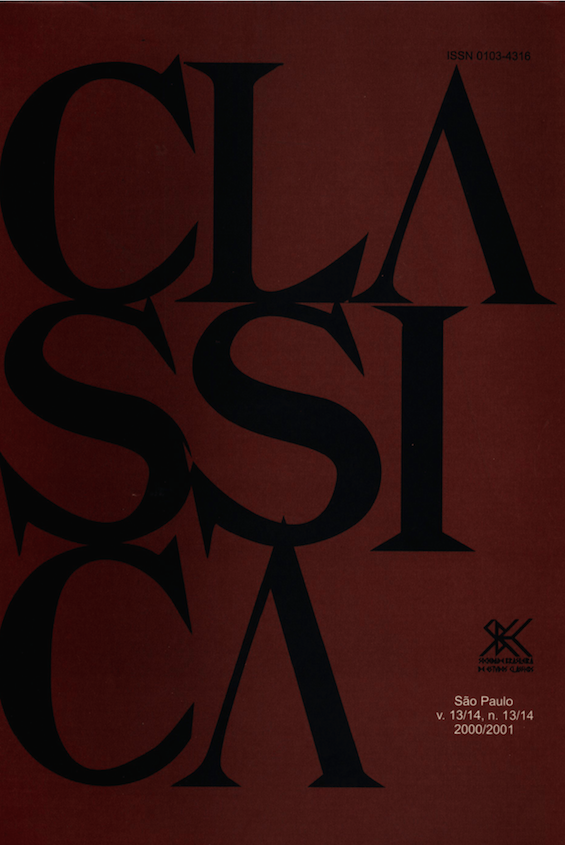Le récit du rapt de Perséphone: interprétations d'un "mythe" et performance rituelle
DOI:
https://doi.org/10.24277/classica.v13i13/14.440Palavras-chave:
Poética, mito grego, Deméter e Perséfone, hermenêutica.Resumo
A narrativa do rapto de Perséfone nos oferece um exemplo ideal para propor, ao mesmo tempo, uma crítica à moderna noção de mito e um percurso pelas diversas interpretações que tal narrativa, considerada como mito, pode suscitar. Somente o estudo de uma versão poética particular, recolocada em suas circunstâncias rituais de enunciação por meio de uma abordagem simultaneamente antropológica e semio-narrativa, é capaz de dar conta dos valores e da função próprios de um mito.
Downloads
Referências
ARTHUR, M. Politics and pomegranates: an interpretation of the Homeric Hymn to Demeter. In: Arethusa 6, 1973, p. 7-47.
BREMMER, J. What is a Greek myth? In: BREMMER, J. (ed.). Interpretations of Greek mythology. Londonl Sydney: Croom Helm, 1987, p. 1-8.
BURKERT, W. Griechische Mythologie und die Geistesgeschichte der Moderne. In: REVERDIN, O. (ed.). Les études classiques aux XIXe et XXe siécles (Entretiens Hardt XXVI). Vandoeuvres/Genève: Fondation Hardt, 1980, p. 159-99.
BURKERT, W. Homo Necans. Interpretationen altgriechischer Opferriten und Mythen, Berlin/New York: de Gruyter, 1972.
CALAME, C. Variations énonciatives, relations avec les dieux et fonctions poétiques dans les Hymnes homériques. In: Mus. Helv. 52, 1995, p. 2-19.
CALAME, C. Mythe et histoire dans l'Antiquité grecque. La création symbolique d'une colonie. Lausanne: Payot, 1996.
CALAME, C. L'Hymne homérique à Déméter comme offrande: regard rétrospectif sur quelques catégories de l'anthropologie de la religion grecque. In: Kernos 10, 1997, p. 111-33.
CALAME, C. (ed.). Métamorphoses du mythe en Grèce antique. Geneve: Labor & Fides, 1988.
CHOROROW, N. Family structure and feminine personality. In ROSALDO, M. Z., LAMPHERE, L. (ed.). Woman, Culture and Society. Stanford: Stanford University Press, 1974, p. 43-66.
D'ALEMBERT, J. & DIDEROT, D. Encyclopédie ou dictionnaire raisonné des sciences, des arts et des meétiers. VIII. Paris: Didot, 1757.
DETIENNE, M. L' lnvention de lu mythologie. Paris: Gallimard, 1981.
FOLEY, H. P. The Homeric Hymn to Demeter: Princeton: Princeton University Press, 1994.
FRAZER, J. G. The golden bough. A study in magic and religion. Part V: Spirits of the Corn and of the Wild I. London: Macmillan, 1913.
GRAF, J. Greek mythology. An inrroduction. Baltimore/London: The Johns Hopkins University Press, 1993.
HENRICHS, A. Three approaches to Greek mythography. In: BREMMER, J. (ed.), Interpretations of Greek mythology. London, Sydney: Croom Helm, 1987, p. 242-77.
JACOB, Ch. L'ordre généalogique. Entre le mythe et l'histoire. In: DETIENNE, M. (ed.). Transcrire les mythologies. Tradition, écriture, historicité. Paris: Albin Michel, 1994, p. 169-202.
JAMME, Ch. Einführung in die Philosophie des Mythos 11. Neuzeit und Gegenwart. Dannstadt: Wissenschaftliche Buchgesellschaft, 1991.
JEANMAIRE, H. Couroi et courètes. Essai sur l'éducation spartiate et sur les rites d'adolescence dans l'antiquité hellénique. Lille: Université, 1939.
KERENYI, K. Kore: zum Mythologem vom Göttlichen Mädchen. In: Paideuma 1,1940, p. 341-80.
KERENYI, K. Eleusis. Archetypal image of mother and daughter. New York: Schocken, 1967 (ed. or. holl. The Hague, 1960).
KILANI, M. L'invention de l'autre. Essais sur le discours anthrpologique. Lausanne: Payot, 1994.
KONSTAN, D. De Deméter a Ceres: construcciones de la diosa en Homero, Calimaco y Ovidio. In: Synthesis 3, 1996, p. 67-90.
LAFITAU, J.-F. Moeurs des sauvages amériquains comparées aux moeurs des premiers temps. Paris: Noury, 1724.
LEVI-STRAUSS, C. Mythologiques I. Le cru et le cuit. Paris: Plon, 1964.
LEVI-STRAUSS, C.. Mythologiques IV. L'homme nu. Paris: Plon, 1971.
LINCOLN, B. The rape of Persephone: a Greek scenario of women's initiation. In: Harv. Theol. Rev. 72, 1979, p. 223-35.
MUELLER, (F.) M. Lectures on the science of language. Second Series. London: Longmans Green, 1881.
NILSSON, M. P. Die eleusinischen Gottheiten. In: Arch. Religionswiss. 32, 1925, p. 79-141 (repris in: Opuscula Selecta 11, Lund: Gleerup, 1952, p. 542-613).
PELLIZER, E. La mitografia. In: CAMBIANO, G., CANFORA, L., LANZA, D. (edd.). Lo spazio letterario nella Grecia antica II. Roma: Salemo, 1993, p. 283-303.
PEPIN, J. Mythe et allégorie. Les origines grecques et les contestations judéo-chrétiennes. Paris: Etudes Augustiniennes,l976 (2e ed.).
RICHARDSON, N. J. The homeric hymn to Demeter: Oxford: Clarendon Press, 1974.
RUDHARDT, J. A propos de l'hyrnne homérique à Déméter. In: Mus. Helv. 35, 1978, p. 1-17.
SAID, S. Approches de la mythologie grecque. Paris: Nathan, 1993.
SHAPIRO, H. A. Art and cult under the ryrants in Athens. Mainz: von Zabem, 1989.
SHAPIRO, H. A. Mousikoi agones: music and poetry at the panathenaia. In: NEILS, J. (ed.). Goddess and polis. The panathenaic festival in ancient Athens. Princeton: Princeton University Press, 1992, p. 53-75.
STRAUSS CLAY, J. The politics of Olympus. Form and meaning in the major homeric hymns. Princeton: Princeton University Press,1987.
VERNANT, J.-P. Mythe et société en Grèce ancienne. Paris: Maspero 1974.
VICO, G. La scienza nuova. Napoli: Mosca, 1744 (2 ed.).
Downloads
Publicado
Edição
Seção
Licença
Autores que publicam nesta revista concordam com os seguintes termos:
a. Autores mantém os direitos autorais e concedem à revista o direito de primeira publicação, com o trabalho simultaneamente licenciado sob a Creative Commons Atribuição 4.0 Internacional (CC BY 4.0) que permite o compartilhamento do trabalho com reconhecimento da autoria e publicação inicial nesta revista.
b. Autores têm autorização para assumir contratos adicionais separadamente, para distribuição não-exclusiva da versão do trabalho publicada nesta revista (ex.: publicar em repositório institucional ou como capítulo de livro), com reconhecimento de autoria e publicação inicial nesta revista.
c. Autores têm permissão e são estimulados a publicar e distribuir seu trabalho online após o processo editorial (ex.: em repositórios institucionais ou na sua página pessoal), já que isso pode gerar alterações produtivas, bem como aumentar o impacto e a citação do trabalho publicado (Veja O Efeito do Acesso Livre).
d. Autores autorizam a cessão, após a publicação, de seu conteúdo para reprodução em indexadores de conteúdo, bibliotecas virtuais, bases de dados de acesso público e similares.











